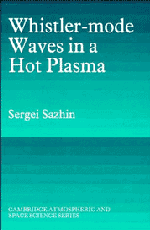Book contents
- Frontmatter
- Contents
- Acknowledgements
- Introduction
- 1 Basic equations
- 2 Propagation in a cold plasma
- 3 Parallel propagation (weakly relativistic approximation)
- 4 Parallel propagation (non-relativistic approximation)
- 5 Quasi-longitudinal approximation
- 6 Quasi-electrostatic approximation
- 7 Growth and damping of the waves
- 8 Non-linear effects
- 9 Applications to the Earth's magnetosphere
- References
- Solutions to the problems
- Index
8 - Non-linear effects
Published online by Cambridge University Press: 30 October 2009
- Frontmatter
- Contents
- Acknowledgements
- Introduction
- 1 Basic equations
- 2 Propagation in a cold plasma
- 3 Parallel propagation (weakly relativistic approximation)
- 4 Parallel propagation (non-relativistic approximation)
- 5 Quasi-longitudinal approximation
- 6 Quasi-electrostatic approximation
- 7 Growth and damping of the waves
- 8 Non-linear effects
- 9 Applications to the Earth's magnetosphere
- References
- Solutions to the problems
- Index
Summary
The linear theory of whistler-mode propagation, growth and damping considered so far has been based on the assumption that waves with different frequencies and wave numbers do not interact with each other (superposition principle) and that the waves do not cause any systematic change in the background particle (electron) distribution function f0. A self-consistent analysis of both these processes creates, in general, a very complicated problem even for modern computers (see e.g. Nunn, 1990). However, in many practically important cases we can develop an approximate analytical theory which takes into account some of these processes and neglects others. This theory, known as the non-linear theory, has been developed during the last 30 years and its results are summarized in numerous monographs and review papers, such as those by Kadomtsev (1965), Vedenov (1968), Sagdeev & Galeev (1969), Tsytovich (1972), Karpman (1974), Akhiezer et al. (1975), Hasegawa (1975), Vedenov & Ryutov (1975), Galeev & Sagdeev (1979), Bespalov & Trakhtengertz (1986), Zaslavsky & Sagdeev (1988), Petviashvili & Pokhotelov (1991) and many others. I have no intention of amending this long list of references by one more contribution. Instead I will restrict myself to illustrating the methods of non-linear theory by two particularly simple examples: the quasi-linear theory of whistler-mode waves (Section 8.1) and the non-linear theory of monochromatic whistler-mode waves (Section 8.2).
Quasi-linear theory
(a) Basic equations
A theory which assumes that the wave amplitude is so small that the superposition principle remains valid, but large enough to provide a non-negligible change of the background electron distribution function ƒo under the influence of the waves, is known as the quasi-linear theory (Akhiezer et al., 1975).
- Type
- Chapter
- Information
- Whistler-mode Waves in a Hot Plasma , pp. 185 - 209Publisher: Cambridge University PressPrint publication year: 1993



